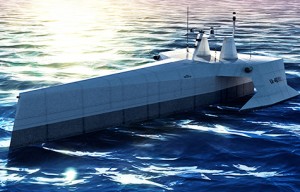 Leidos, a national security, health, and engineering solutions company, completed a total of 42 days of at-sea demonstrations of the prototype maritime autonomy system designed to control all of the maneuvering and mission functions of the Defense Advanced Research Projects Agency’s (DARPA) Anti-Submarine Warfare Continuous Trail Unmanned Vessel (ACTUV). Using a 32-foot work boat as a surrogate vessel, Leidos installed autonomy software and sensors to mimic the configuration intended for an eventual full-size ACTUV prototype.
Leidos, a national security, health, and engineering solutions company, completed a total of 42 days of at-sea demonstrations of the prototype maritime autonomy system designed to control all of the maneuvering and mission functions of the Defense Advanced Research Projects Agency’s (DARPA) Anti-Submarine Warfare Continuous Trail Unmanned Vessel (ACTUV). Using a 32-foot work boat as a surrogate vessel, Leidos installed autonomy software and sensors to mimic the configuration intended for an eventual full-size ACTUV prototype.
Manned vessels are obliged to obey a set of navigation rules published by the International Maritime Organization. Generally referred to as COLREGS (collision regulations), those rules determine in the event of an encounter between vessels, which vessel has the right of way (the “stand on” vessel) and the appropriate behavior for both the “stand on” and “give way” vessel to avoid a collision.
The Leidos strategy to evaluate the prototype ACTUV autonomy system for COLREGS compliance includes both simulation and at-sea testing. The team has completed approximately 26,000 simulation runs of the system. Testing of COLREGS involves the ACTUV surrogate and one interfering vessel in a variety of meeting, crossing, overtaking and transit scenarios in both simulation and on the water test events.
During a recent on-the-water test event, the surrogate boat autonomously navigated through narrow channels avoiding navigation aids and submerged hazards. The boat safely avoided surface ships it encountered along the route, satisfying COLREGS requirements in completely unscripted events.
During 42 days of at-sea testing that included 101 individual scenarios, the autonomy system directed course and speed changes of the surrogate vessel to stay safely outside a 1-km standoff distance from the interfering vessel. The test program demonstrated the ability of the ACTUV autonomy system to successfully maneuver and avoid collision with another vessel and paves the way for follow-on testing involving multiple interfering contacts and adversarial behaviors of interfering vessels.
While continuing to use the surrogate vessel to test ACTUV software and sensors, construction of Sea Hunter, the first ACTUV vessel, continues at Christensen Shipyard in Clackamas, Oregon. Sea Hunter is scheduled to launch in late summer 2015 and begin testing in the Columbia River shortly thereafter.


















